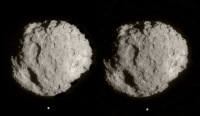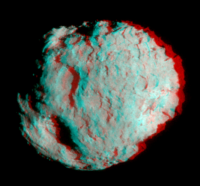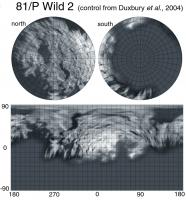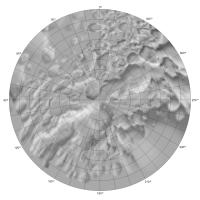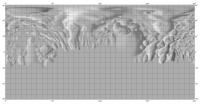Printable Version of Topic
Click here to view this topic in its original format
Unmanned Spaceflight.com _ Cometary and Asteroid Missions _ Stardust Raw Images Of Wild 2
Posted by: elakdawalla Jan 10 2006, 09:40 PM
I just created an index page to the 72 raw images captured by Stardust of Wild 2 on the day of the encounter (downloading the original images from the PDS in a jiffy with that wGet software -- what a great innovation):
http://www.planetary.org/explore/topics/asteroids_and_comets/wild2_stardust.html
As I was working with it to compose more stuff about Wild 2 for our website I realized that all those raw images are flipped left-to-right. Compare this one:
to the maps from the Brownlee et al Science publication:

I am assuming that these (as well as the ones in the Sekanina et al paper that follows it) have the correct orientation.
And yet the most famous picture of Wild 2, the one used for the cover of Science in fact, has not been flipped.
This is really key (and confusing) in part because of the team's names for those big, flat-floored depressions -- Left and Right Foot. Which one's left and which one's right depends on whether the images have been flipped or not!
I'm sure this is not news to people who paid more attention to Stardust when the encounter happened than I did. Does anybody here know anything about why the images in the PDS are flipped?
--Emily
Posted by: djellison Jan 10 2006, 09:59 PM
Didnt the Stardust camera employ a mirror to flip the view? Might have had something to do with it. Either they didnt compensate for it when did the press imagery and have for the raw release, or vice-versa.
Looking at this - http://www.nasa.gov/mov/139826main_stardust-trajectory.mov - the spacecraft was overtaken by the comet in a deep-impact style. So, if you were a human spacecraft, with your head 'up' (i.e. standing in the same orientation as one would stood on the north pole of earth) - the comet would have travelled from right to left.
Thus - the early images should have the shadowed side of the comet on the left, and the last images the shadow on the right - or to put it another way - the comet should start with the lighting from the right, and finish with it being lit from the left.
i.e. the sequence as it sits on that (very very good) website is geometrically wrong.
Now - the problem is - you could take an image that appears to be the wrong way round, and either rotate 180 degrees, or flip horez, and have different results. Now - if the PDS released data is as it came from the CCD - then it will need to be flipped left to right.
I think ![]()
Much kudos on the website - did you do that pulling-of-data-from-PDS headers all by hand ![]()
Doug
Posted by: elakdawalla Jan 10 2006, 10:04 PM
Aha! A mirror! I think you've figured out the puzzle. It did in fact use an articulated scan mirror for pointing -- of course that would produce a mirror-image on the CCD. Too bad they didn't take that out of the PDS release, though I guess what's in the PDS does accurately reflect what hit the CCD.
--Emily
Posted by: elakdawalla Jan 10 2006, 10:07 PM
Nope, it all came from the oh-so-wonderful INDEX.TAB file, which can always be found in the INDEX folder in every disk from the PDS. The file consists of tons of columns of data, the significance of which you can discover from inspection of the INDEX.LBL file in the same folder. For grins, I've attached my translation of the Stardust Wild 2 disk's INDEX.LBL file.
I open the INDEX.TAB file in Excel, mess around with it, move columns, play with number formatting, concatenate things together into strings, bring that into Word, split things into paragraphs (Find and Replace is my friend), and then copy and paste the captions I've built into my database-driven image library to make the Web page. Easy as pie
--Emily
Posted by: The Messenger Jan 10 2006, 10:27 PM
And yet the most famous picture of Wild 2, the one used for the cover of Science in fact, has not been flipped.

This is really key (and confusing) in part because of the team's names for those big, flat-floored depressions -- Left and Right Foot. Which one's left and which one's right depends on whether the images have been flipped or not!
--Emily
It is even more confusing that that: Megaminors are known to have inverted feet - the heel of the foot is much wider than the ball, so if these are Megaminors footprints, the left foot is indeed the right one
Edit: invisible verb
Posted by: machi Feb 3 2011, 12:50 PM
Stereo images of Wild 2 comet.
Anaglyph and cross-eye versions.
Wild 2 has arguably wackiest surface of all visited planets, comets and asteroids.
Posted by: dilo Feb 3 2011, 03:23 PM
Really impressive structure, indeed!
Thanks, machi.
Posted by: Phil Stooke Feb 3 2011, 07:41 PM
Beautiful!
Phil
Posted by: Phil Stooke Mar 12 2012, 03:53 PM
Returning to an old thread - I hope that's OK but it seems unnecessary to start a new one.
I have been experimenting with a shaded relief drawing of the nucleus of Wild 2. The coordinate system is from a paper by Duxbury et al.
Starting with this mosaic (labelled with west longitudes):
I tried to interpret it in shaded relief, a bit tricky in places, so I can't guarantee it is right everywhere. Note I'm using east longitudes in the new map.
Phil
(PS - these plus my completed Itokawa photomosaic were just submitted to the PDS Small Bodies Node archive)
Powered by Invision Power Board (http://www.invisionboard.com)
© Invision Power Services (http://www.invisionpower.com)


